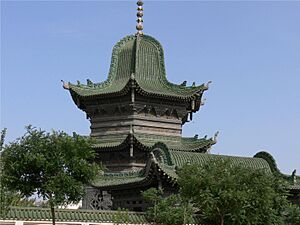Ma Hualong facts for kids
Ma Hualong (Chinese: 马化龙) was an important leader of the Jahriyya. This was a special group of Muslims called a Sufi order (or 'menhuan' in Chinese) in northwestern China.
From 1862, he was one of the main leaders of a big rebellion. This rebellion was against the Qing Dynasty (the rulers of China at that time). He led this fight until he surrendered and died in 1871.
Biography
Ma Hualong became the leader of the Jahriyya around 1849. He took over from the group's fourth spiritual leader, Ma Yide. The Jahriyya group was first started by Ma Mingxin in central Gansu province.
By the time Ma Hualong became leader, the group's main center was in northern Ningxia. This area was also part of Gansu Province back then. Their headquarters were in a town called Jinjipu. This town was a few kilometers south of today's Wuzhong City.
Jinjipu became a very important place for religion and trade. The leaders of the Jahriyya grew rich. They made a lot of money from trading goods using camels. Their trade routes went across Inner Mongolia, connecting places like Baotou, Huhhot, and Beijing.
When the Muslim Rebellion started in 1862, Ma Hualong stayed at the Jahriyya headquarters in Jinjipu. The areas he directly led included the eastern parts of Gansu Province. This is today's Ningxia and the easternmost parts of modern Gansu.
Other rebel leaders were in different parts of Gansu. For example, Ma Zhan'ao was in Hezhou. Ma Guiyuan was in Xining, and Ma Wenlu was in Suzhou (Jiuquan). Historians today believe these leaders mostly acted on their own. However, members of the Jahriyya group, who all followed Ma Hualong, joined the rebellion across the whole region.
At times during the rebellion, Ma Hualong talked with the government. At least once, he even gave up. He changed his name to "Ma Chaoqing," which meant "someone who helps the Qing government." But he didn't break up his fighting groups. Instead, he kept making Jinjipu stronger. He also worked with other rebels who had come to Gansu from Shaanxi.
In July 1869, Qing Dynasty forces surrounded Ma Hualong in Jinjipu. General Zuo Zongtang led these forces. The government troops captured the forts outside the town. People inside the walls started to run out of food. Ma Hualong surrendered in January 1871, hoping to save his people's lives.
However, once Zuo's troops entered Jinjipu, many people were killed, and the town was destroyed. Accounts of Ma Hualong's death are different. He was likely executed on March 2, 1871, by Zuo's orders. His son Ma Yaobang and over eighty rebel officials were also executed. Some people said he was killed by a traitor from his own group.
Family and Survival
Only a few of Ma Hualong's family members survived the terrible events at Jinjipu.
General Zuo executed many of Ma Hualong's relatives. However, his daughter and grandson were spared. The grandson, named Ma Tsen-wu, was sent to Yunnan province.
Legacy
Followers of the Jahriyya in Ningxia believe Ma Hualong's grave is in Dongta Town. This town is now a part of Wuzhong City. A special tomb shrine called Siqiliangzi gongbei (Chinese: 四旗梁子拱北) has been built there. In 1985, more than 10,000 people from all over China came to a special ceremony (called 'ermaili') at this site.
However, some other Jahriyya followers have a different belief. They think Ma Hualong's real tomb is in Xuanhuagang. This place is in Gansu's Zhangjiachuan Hui Autonomous County. This county was also where Ma Hualong's successor, Ma Yuanzhang, was based.
Some writers try to combine these two beliefs. They say that Ma Hualong's body is in Dongta. They believe his head is buried in Zhangjiachuan.


